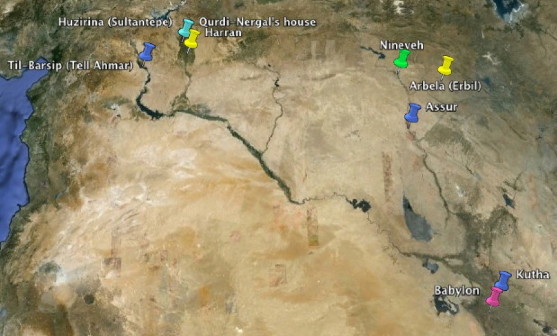Qurdi-Nergal's house in Huzirina
A library was discovered and partly removed in the last ten days of the first excavation season of May-June 1951, in the site of Sultantepe, ancient Huzirina, near Sanliurfa in Turkey. During the second season, the remaining tablets were excavated. The archaeologists were led by N. Gökçe and S. Lloyd with O. Gurney as epigraphist. Sultantepe was no longer excavated. It is difficult to understand what happened to the scholarly tablets in ancient times, for three reasons. First, it was only possible to excavate at the edges of the tell. Second, the excavations were very brief. Furthermore, publications about those seasons are just preliminary reports.
Excavations and finds
The tablets were not found in primary context but had been hidden, at the end of Assyrian times, outside the buildings of the north-east part of the acropolis. The archaeologists discovered them directly beneath the surface, stacked against a mud-brick wall of 1 metre thick. Beyond the wall, on its south side, a room (F 2) was cleared that belonged to a building which was probably a private dwelling-house. The house itself was then designated as the 'House of Qurdi-Nergal', one of the most frequent names in the colophons of the tablets hidden outside room F 2. Three chambers were found for this building: F 2, F 3 and F 4. Although it was highly eroded, this part of the building seems to have been composed of rooms surrounding the open space F 5. Chamber F 4 was used as an entrance vestibule since it had a doorway and the open area F 5 had a prestigious aspect, with a stone and baked-brick pavement. All the structures were badly damaged by later pits and graves.
The tablet hoard

The Huzirina/scholarly network. View the Huzirina scholarly network in Google Maps.
In area F 1 was the hiding place of the tablets that the archaeologists named the 'Tablet Hoard'. F 1 seems to have been another open space, outside the 'House of Qurdi-Nergal'. The tablets were carelessly deposited against the outer wall of the house but in a protected position. The tablets were protected by a small offering-table or pedestal (measuring 1m/0.55m/0.30m), projecting from the wall. In the angle between it and the wall two large wine-jars and five more jars were placed in a semicircle. This arrangement was completed with large stones that appeared to have been used as a kind of barrier. Stone, pottery vessels and a carved offering-table had been added to the hiding place. Because of them, the tablets were scattered over the pavement beyond. Some other tablets were found among the ashes of bread oven one metre to the north of the area protected by the wine-jars. F 1 was pierced by numerous later grain-pits. The main question concerning this deposit is whether the tablets were deliberately stacked or thrown out as refuse. Other cuneiform tablets were also discovered on the site. They were mostly legal documents but a single baked fragment from a medical composition was found in the open space F 5, in the 'House of Qurdi-Nergal'.
Some human bones associated with the F 1 level lay near the hiding place, testimony of a violent end to the Assyrian town? Huzirina seems to have been destroyed in 610. Indeed, the outer doorway from F 4 to F 1 was damaged by a burial which can be dated by Scythian artefacts, and Scythians belonged to the army which took Harran in 610.
View the Huzirina network in Google Maps [http://maps.google.com/maps?q=http://oracc.museum.upenn.edu/gkab/downloads/huzirina_network.kmz&t=k&z=14].
The tablets today
407 scholarly tablets and fragments were discovered in Huzirina. This number represents many fragments of a smaller number of original tablets. They are all published in STT 1 and 2 (below). All the tablets are now in the Archaeological Museum at Ankara.
Bibliography
- Gurney and Finkelstein, Sultantepe Tablets I, 1957.
- Gurney and Hulin, Sultantepe Tablets II, 1964.
- Lloyd and Gökçe, 'Sultantepe 1952', 1953.
Philippe Clancier
Philippe Clancier, 'Qurdi-Nergal's house in Huzirina', The Geography of Knowledge, The GKAB Project, 2019 [http://oracc.museum.upenn.edu/cams/gkab/contexts/huzirina/]